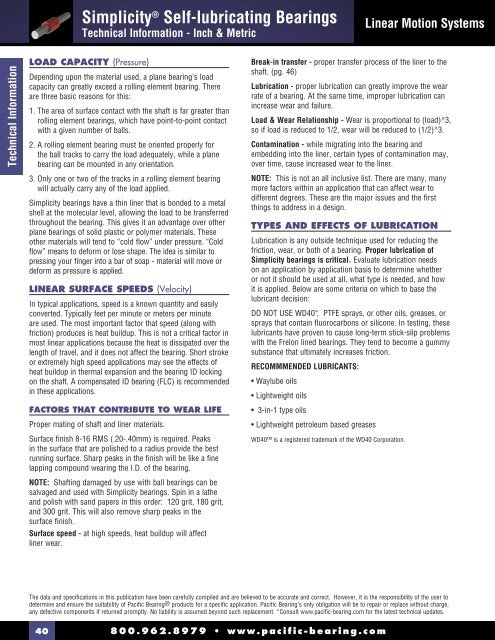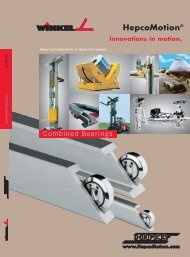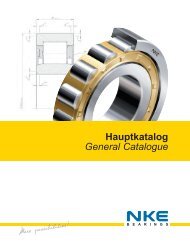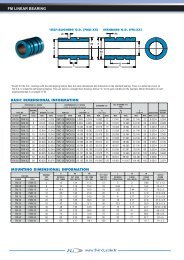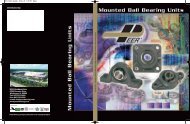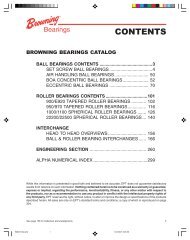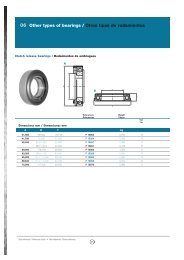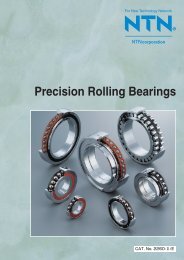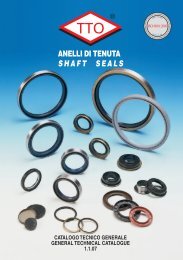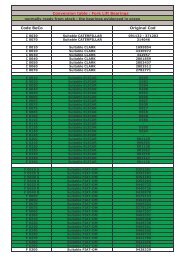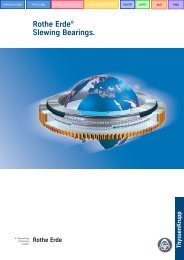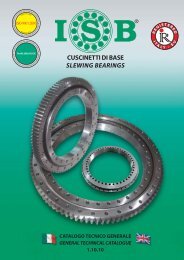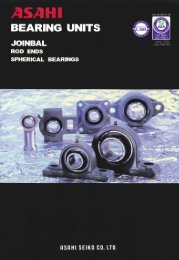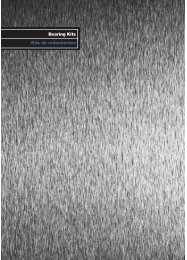LINEAR MOTION SYSTEMS
LINEAR MOTION SYSTEMS
LINEAR MOTION SYSTEMS
You also want an ePaper? Increase the reach of your titles
YUMPU automatically turns print PDFs into web optimized ePapers that Google loves.
Simplicity ® Self-lubricating Bearings<br />
Technical Information - Inch & Metric<br />
Linear Motion Systems<br />
Technical Information<br />
LOAD CAPACITY (Pressure)<br />
Depending upon the material used, a plane bearing’s load<br />
capacity can greatly exceed a rolling element bearing. There<br />
are three basic reasons for this:<br />
1. The area of surface contact with the shaft is far greater than<br />
rolling element bearings, which have point-to-point contact<br />
with a given number of balls.<br />
2. A rolling element bearing must be oriented properly for<br />
the ball tracks to carry the load adequately, while a plane<br />
bearing can be mounted in any orientation.<br />
3. Only one or two of the tracks in a rolling element bearing<br />
will actually carry any of the load applied.<br />
Simplicity bearings have a thin liner that is bonded to a metal<br />
shell at the molecular level, allowing the load to be transferred<br />
throughout the bearing. This gives it an advantage over other<br />
plane bearings of solid plastic or polymer materials. These<br />
other materials will tend to “cold flow” under pressure. “Cold<br />
flow” means to deform or lose shape. The idea is similar to<br />
pressing your finger into a bar of soap - material will move or<br />
deform as pressure is applied.<br />
<strong>LINEAR</strong> SURFACE SPEEDS (Velocity)<br />
In typical applications, speed is a known quantity and easily<br />
converted. Typically feet per minute or meters per minute<br />
are used. The most important factor that speed (along with<br />
friction) produces is heat buildup. This is not a critical factor in<br />
most linear applications because the heat is dissipated over the<br />
length of travel, and it does not affect the bearing. Short stroke<br />
or extremely high speed applications may see the effects of<br />
heat buildup in thermal expansion and the bearing ID locking<br />
on the shaft. A compensated ID bearing (FLC) is recommended<br />
in these applications.<br />
FACTORS THAT CONTRIBUTE TO WEAR LIFE<br />
Proper mating of shaft and liner materials.<br />
Surface finish 8-16 RMS (.20-.40mm) is required. Peaks<br />
in the surface that are polished to a radius provide the best<br />
running surface. Sharp peaks in the finish will be like a fine<br />
lapping compound wearing the I.D. of the bearing.<br />
NOTE: Shafting damaged by use with ball bearings can be<br />
salvaged and used with Simplicity bearings. Spin in a lathe<br />
and polish with sand papers in this order: 120 grit, 180 grit,<br />
and 300 grit. This will also remove sharp peaks in the<br />
surface finish.<br />
Surface speed - at high speeds, heat buildup will affect<br />
liner wear.<br />
Break-in transfer - proper transfer process of the liner to the<br />
shaft. (pg. 46)<br />
Lubrication - proper lubrication can greatly improve the wear<br />
rate of a bearing. At the same time, improper lubrication can<br />
increase wear and failure.<br />
Load & Wear Relationship - Wear is proportional to (load)^3,<br />
so if load is reduced to 1/2, wear will be reduced to (1/2)^3.<br />
Contamination - while migrating into the bearing and<br />
embedding into the liner, certain types of contamination may,<br />
over time, cause increased wear to the liner.<br />
NOTE: This is not an all inclusive list. There are many, many<br />
more factors within an application that can affect wear to<br />
different degrees. These are the major issues and the first<br />
things to address in a design.<br />
TYPES AND EFFECTS OF LUBRICATION<br />
Lubrication is any outside technique used for reducing the<br />
friction, wear, or both of a bearing. Proper lubrication of<br />
Simplicity bearings is critical. Evaluate lubrication needs<br />
on an application by application basis to determine whether<br />
or not it should be used at all, what type is needed, and how<br />
it is applied. Below are some criteria on which to base the<br />
lubricant decision:<br />
DO NOT USE WD40 , PTFE sprays, or other oils, greases, or<br />
sprays that contain fl uorocarbons or silicone. In testing, these<br />
lubricants have proven to cause long-term stick-slip problems<br />
with the Frelon lined bearings. They tend to become a gummy<br />
substance that ultimately increases friction.<br />
RECOMMMENDED LUBRICANTS:<br />
• Waylube oils<br />
• Lightweight oils<br />
• 3-in-1 type oils<br />
• Lightweight petroleum based greases<br />
WD40 is a registered trademark of the WD40 Corporation.<br />
The data and specifi cations in this publication have been carefully compiled and are believed to be accurate and correct. However, it is the responsibility of the user to<br />
determine and ensure the suitability of Pacifi c Bearing® products for a specifi c application. Pacifi c Bearing’s only obligation will be to repair or replace without charge,<br />
any defective components if returned promptly. No liability is assumed beyond such replacement. *Consult www.pacifi c-bearing.com for the latest technical updates.<br />
40<br />
800.962.8979 • www.pacific-bearing.com


